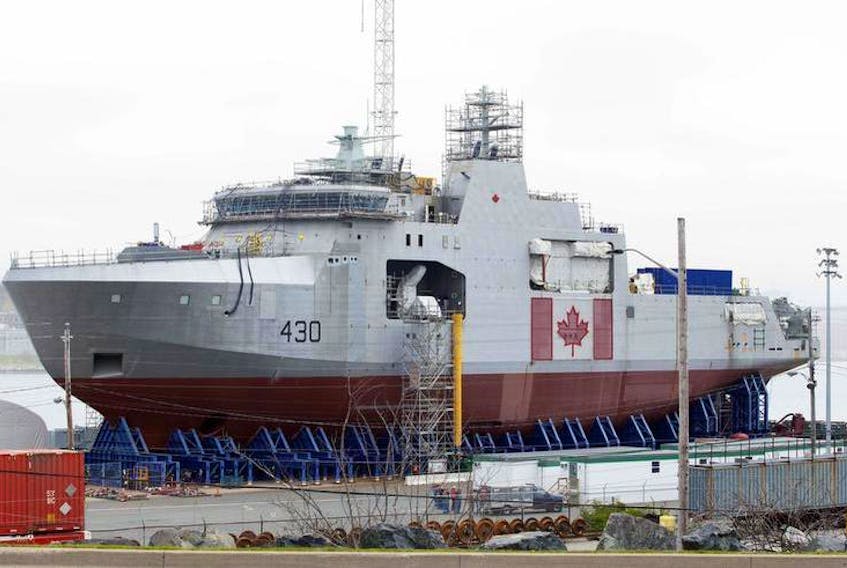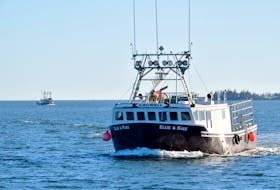Building a sixth Harry DeWolf-class offshore patrol vessel will increase naval readiness and cut the looming production gap at Irving Shipyards, experts say — but questions remain about the $810 million price tag.
On Friday, a day after announcing it would be splitting maintenance on its fleet of Halifax-class ships between three shipyards, the federal government confirmed plans to build a sixth Arctic Offshore Patrol Ship (AOPS). Though the planned build was for “up to six” icebreakers, only five had been formally part of the contract with Irving Shipbuilding in Halifax.
Ken Hansen, a retired navy commander and defence analyst, said a sixth ship will ensure there is at least one vessel on each coast ready to deploy at all times while the others are in various stages of the maintenance cycle.
“It comes down to this business of readiness. It’s a bit complicated but essentially it takes three ships to keep one in operation,” Hansen told The Chronicle Herald.
Rear Admiral Craig Baines said as much at Friday’s announcement on the sixth vessel.
“It’s really important for us to be able to operate in the three oceans and internationally, and to be able to do that on both coasts you need to have that many ships,” he told reporters. “To be able to put four out the door you need six, because at any given time you’re going to have two ships in maintenance.”
Hansen said this will be especially useful considering how versatile the AOPS are.
He said while the frigates will be mostly used for large military exercises, or if necessary, if any major conflict arises, the AOPS will be like the navy’s pickup truck.
“The really busy ships are going to be the Harry DeWolf-class ships. They’re going to run everywhere and do everything,” he said.
Even though their main purpose in the navy is to patrol icy waters of Canada that are otherwise inaccessible, because the vessels can be outfitted with anything that can be containerized — like a small lab, or hospital — Hansen said they will be great for humanitarian and science missions, and even as training platforms as there are extra accommodations on board.
“It’s only limited by your imagination what these ships can do,” he said.
But, Hansen said, not everyone in the navy will be thrilled about plans to build a sixth.
“Some will view it as a draw on resources that should be going to the combat fleet,” he said.
“If you’re going to put one (extra) ship in to a small fleet with a fairly small manpower base you have to take it out of somewhere else. It will create a real squeeze for resources, mostly human resources, and it means you have to put more people through the training pipeline for things that are specifically related to what that ship is going to do in these non-combat missions.”
Aside from improving naval readiness and versatility, the government is also touting the sixth ship as a way to close the production gap at Irving Shipyards between the completion of the AOPS and the start of the Canadian surface combatant project. Irving, as well as the shipyard union, had previously warned of potential layoffs at the yard due to an expected 36-month gap between the two projects, but the government now says the sixth ship will cut that by about 18 months.
David Perry, senior analyst with the Canadian Global Affairs Institute, said this will hopefully smooth out the production cycle.
“This will help keep their production line hot to get more efficiencies in the Canadian surface combatant production, to help them retain talent, not have to have their management split between trying to get the design and all the production details ironed out on CSC and at the same time they’re also having to go out and rehire talent and bring them back into the shipyard,” Perry said.
But even with an 18-month production hiatus, Hansen said he still expects to see some layoffs — especially now that the Halifax-class maintenance is being split up — unless Irving is able to get some supplementary work either with the government or other countries.
In an emailed statement, the Department of National Defence said the addition of the sixth ship is expected to increase the cost of the AOPS project by $810 million, bringing the contract’s ceiling cost from $2.3 billion to a total of $2.8 billion including taxes.
The $810 million is broken down into three parts: the cost of the ship, which is roughly $400 million, extension of the production schedule by 18 months, which will cost about $150 million, and increased amounts for “adjustments” like labour rates, project office costs, foreign exchange, and economic price adjustments that will add an expected $250 million.
The department said the $250 million for adjustments are for projects costs not associated with the actual amount going to Irving, which is why the contract’s ceiling cost increased by $550 million.
Perry said this increase — equal to 35 per cent of the initial project budget — is far more than he was expecting since adding a ship at the end of a production run is usually fairly inexpensive considering all the efficiencies that should be realized by that point, leaving him with some questions. Perry said it’s not clear if the costs associated with the additional 18 months is exclusively for the sixth ship or part of an overall change in the production schedule.
In an email, DND said the new schedule will result in an adjustment to the overall timeline, but that the delivery of the first AOPS has not changed.
“It is still planned for summer 2019. ... The new schedule will not impact operations.”
RELATED:









